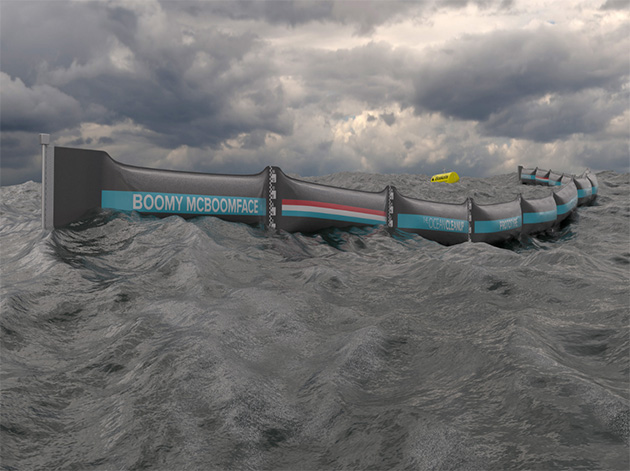Watch a test of the BottleBuoy rescue device, which has just won one of the first ever H.E.R.O. awards from the International Maritime Rescue Federation (IMRF).
17 November
An innovative piece of low-cost rescue equipment, supported through its development by the RNLI and Bournemouth University, has won one of the first ever Honouring Excellence in Rescue Operations (H.E.R.O.) awards from the International Maritime Rescue Federation (IMRF).
The RNLI’s International team won in the technology category for its BottleBuoy project with concept designer James Benson and the design team from Bournemouth University.
The simple flotation device is a sustainable and affordable idea with the potential to save lives in areas where funds for rescue equipment are limited.
It is aimed at low resource communities and can be used as public rescue equipment and for swimming instruction.

Testing of the BottleBuoy in Bangladesh. Credit: RNLI
The device is simple and allows three plastic soft drink/water bottles to be attached to a central hub.
Instructions and a simple template have been developed to allow the BottleBuoy to be produced in local communities using items that can be found easily – discarded plastic drinks bottles are now in abundance in many low resource environments.
Production development and user testing has been undertaken in Bangladesh in partnership with Bournemouth University’s Faculty of Science and Technology and the SeaSafe lifeguard service in Cox’s Bazar, a joint partnership between the RNLI and the CIPRB (Centre for Injury Prevention, Bangladesh).
It has now been tested closer to home too, at the Sea Survival Centre at RNLI College and in the sea off Cromer, Norfolk, with the support of local lifeguard and lifeboat teams.
The BottleBuoy is now in use in Bangladesh and will undergo further testing before a final resource manual is made available by the RNLI in 2017.
10 November
A potentially lifesaving rescue device, known as the BottleBuoy, is being trialled in the UK for the first time by the RNLI.
The flotation device consists of three empty plastic bottles screwed into a central core.
Once the bottles are locked in place, the resulting object is a three pointed star which can be thrown to a casualty in the water to keep them afloat.
The ingeniously simple device is cheap to manufacture and has already piqued the interest of the RNLI’s international team, who subsequently trialled it in the sea in Bangladesh in May.
The promising results of those tests led to the RNLI’s decision to carry out more vigorous tests on home soil, to ascertain the potential future lifesaving benefits.
The test will take place off the coast of Norfolk at Cromer Pier on 10 November, 2016.
Explaining more about the BottleBuoy, Stuart Thompson from the RNLI’s International Development team, said: “It’s one of those ideas that, when you see it, you can’t quite believe how simple it is, or why no-one has thought of it before.”
“It’s a plastic or wooden core which you secure three bottles to. The bottles are empty and sealed, and the air trapped inside gives the device incredible buoyancy – enough to keep a casualty afloat in the water until help can arrive,” he stated.

The latest BottleBuoy Plastic Edition. Credit: http://bottlebuoy.com/
The BottleBuoy is the brainchild of Huddersfield student James Benson.
He came up with the idea, built a prototype, and entered an International Maritime Rescue Federation (IMRF) competition.
The RNLI learned of it, and approached Benson to see if the BottleBuoy could play a part in rescues in low or middle income countries.
“We have links with the IMRF and since learning about the buoy we been working closely with James to assess how easily it could be mass produced,” stated Thompson.
“In May we ran some trials with an injury prevention organisation called the Centre for Injury Prevention and Research, Bangladesh.This was part of our international work to improve search and rescue capacity in countries with high drowning rates,” he continued.
“We found the initial results really encouraging so now we want to put the BottleBuoy through its paces a little more. We have tested it in the RNLI Sea Survival Pool at our RNLI headquarters in Dorset, where all of our volunteer lifeboat crew members do their training,” he explained.
“In the sea at Cromer we’ll see if it can be reliably thrown over a distance, how far, whether it can keep more than one person afloat, whether it works with a line attached to aid recovery, how it fares in different sea conditions etc,” said Thompson.
The RNLI said the BottleBuoy’s original design was recreated by a local carpenter in Bangladesh out of wood, but a plastic version could easily be injection moulded and potentially mass produced for relatively little cost.
And any measures which potentially reduce the amount of waste plastic must be a good thing, given that plastic constitutes approximately 90 percent of all trash floating on the ocean’s surface, stated the charity.
The RNLI’s International programme works with local and national partners to tackle the global drowning epidemic, which kills an estimated 372,000 people every year.
As well as interventions and training, the charity work with countries to help put national water safety strategies in place.
Hrönn: World’s first unmanned and fully-automated ship
Construction on Hrönn is expected to begin in January and will be the first full size unmanned ship to be…
A step closer towards ridding oceans of plastic
Ambitious plans to rid the world's oceans of plastic have now moved forward as the Ocean Cleanup unveil its first…




